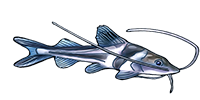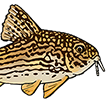/siluriformes/loricariidae/pseudacanthicus/pirarara/1.jpg)
/siluriformes/loricariidae/pseudacanthicus/pirarara/2.jpg)
/siluriformes/loricariidae/pseudacanthicus/pirarara/3.jpg)
/siluriformes/loricariidae/pseudacanthicus/pirarara/4.jpg)
/siluriformes/loricariidae/pseudacanthicus/pirarara/5.jpg) Dorsal view of female
Dorsal view of female/siluriformes/loricariidae/pseudacanthicus/pirarara/6.jpg) Female - close-up of head
Female - close-up of head/siluriformes/loricariidae/pseudacanthicus/pirarara/7.jpg)
/siluriformes/loricariidae/pseudacanthicus/pirarara/8.jpg)
/siluriformes/loricariidae/pseudacanthicus/pirarara/9.jpg)
/siluriformes/loricariidae/pseudacanthicus/pirarara/10.jpg) Female - close-up of pectoral odontodes
Female - close-up of pectoral odontodes/siluriformes/loricariidae/pseudacanthicus/pirarara/11.jpg) Close-up of pectoral odontodes
Close-up of pectoral odontodes/siluriformes/loricariidae/pseudacanthicus/pirarara/12.jpg) Dorsal view
Dorsal view/siluriformes/loricariidae/pseudacanthicus/pirarara/13.jpg)
/siluriformes/loricariidae/pseudacanthicus/pirarara/14.jpg) Male with eggs in cave
Male with eggs in cave/siluriformes/loricariidae/pseudacanthicus/pirarara/15.jpg) Male close-up
Male close-up/siluriformes/loricariidae/pseudacanthicus/pirarara/16.jpg) Female close-up
Female close-up/siluriformes/loricariidae/pseudacanthicus/pirarara/17.jpg)
/siluriformes/loricariidae/pseudacanthicus/pirarara/18.jpg) Female - close-up of body odontodes
Female - close-up of body odontodes Video
Video/siluriformes/loricariidae/pseudacanthicus/pirarara/20.jpg)
/siluriformes/loricariidae/pseudacanthicus/pirarara/21.jpg) Egg clutch
Egg clutch/siluriformes/loricariidae/pseudacanthicus/pirarara/22.jpg) Six day old fry
Six day old fry/siluriformes/loricariidae/pseudacanthicus/pirarara/23.jpg) Nine day old fry
Nine day old fry/siluriformes/loricariidae/pseudacanthicus/pirarara/24.jpg) Twelve day old fry
Twelve day old fry/siluriformes/loricariidae/pseudacanthicus/pirarara/25.jpg) Fifeteen day old fry
Fifeteen day old fry/siluriformes/loricariidae/pseudacanthicus/pirarara/26.jpg) Nineteen day old fry
Nineteen day old fry/siluriformes/loricariidae/pseudacanthicus/pirarara/27.jpg) Twenty three day old fry
Twenty three day old fry/siluriformes/loricariidae/pseudacanthicus/pirarara/28.jpg) Thirty seven day old fry
Thirty seven day old fry/siluriformes/loricariidae/pseudacanthicus/pirarara/29.jpg) Forty five day old juvenile
Forty five day old juvenile/siluriformes/loricariidae/pseudacanthicus/pirarara/30.jpg) Sixty day old juvenile
Sixty day old juvenile/siluriformes/loricariidae/pseudacanthicus/pirarara/31.jpg) Eighty two day old juvenile
Eighty two day old juvenile/siluriformes/loricariidae/pseudacanthicus/pirarara/32.jpg) Ninety four day old juvenile
Ninety four day old juvenile/siluriformes/loricariidae/pseudacanthicus/pirarara/33.jpg) Four month old juvenile
Four month old juvenile/siluriformes/loricariidae/pseudacanthicus/pirarara/34.jpg) Five month old juvenile
Five month old juvenile/siluriformes/loricariidae/pseudacanthicus/pirarara/35.jpg) Seven month old juvenile
Seven month old juvenile/siluriformes/loricariidae/pseudacanthicus/pirarara/36.jpg) Eight months, two week old juvenile
Eight months, two week old juvenile/siluriformes/loricariidae/pseudacanthicus/pirarara/37.jpg)
/siluriformes/loricariidae/pseudacanthicus/pirarara/38.jpg)
/siluriformes/loricariidae/pseudacanthicus/pirarara/39.jpg) Close-up of mouth
Close-up of mouth/siluriformes/loricariidae/pseudacanthicus/pirarara/40.jpg) Close-up of head
Close-up of head/siluriformes/loricariidae/pseudacanthicus/pirarara/41.jpg) Collected at mouth of Rio Iriri
Collected at mouth of Rio Iriri/siluriformes/loricariidae/pseudacanthicus/pirarara/42.jpg)
| Scientific Name | Pseudacanthicus pirarara Chamon & Sousa, 2016 |
| Common Names | L025, Scarlet Cactus Pleco Rødfinnet Kaktussugemalle (Denmark) |
| Type Locality | Rio Xingu, Senador José Porfírio, Pedral do Caitucá, Brazil, 3°34'24"S, 51°51'33"W. |
| Pronunciation | SUE dah KAN thi cuss |
| Etymology | Pseud- Greek: False, Acanthicus - Greek: Spiny, Thorny. Literally "False Acanthicus" referring to this genus being similar to, yet different from, Acanthicus. The specific epithet is derived from local fishermen's common name for this species, the "assacu-pirarara:" Pirarara refers to the species' reddish fins (this is also the Brazilian common name the red tail catfish, Phractocephalus hemioliopterus); "Assacu" is a common name for the Amazon tree Hura crepitans, which has bark covered with conical spines. |
| Articles | |
| Size | 450mm or 17.7" SL. Find near, nearer or same sized spp. |
| Identification | The German common name for this genus is ''Cactus Pleco''. A good name! Pseudacanthicus is a member of the Acanthicus clade. Species of the Acanthicus clade are distinguished from other Loricariidae species by the presence of (1) longitudinal rows of keels (pointed odontodes) along the body sides; (2) eight or more dorsal-fin rays (vs. six or seven in most other loricariids except Pterygoplichthys, Chaetostoma, Pogonopoma and Pseudancistrus pectegenitor); (3) seven to eight infraorbitals (vs. usually five or six); (4) five anal-fin branched rays (vs. usually four); and (5) presence of hypertrophied odontodes along the snout margin (vs. hypertrophied odontodes absent in other loricariids except Isbrueckerichthys and Pareiorhaphis, in Neoplecostominae; Panaque and Pseudancistrus and Neblinichthys, in Ancistrini; and most dimorphic males of Loricariinae). Within the Acanthicus group, Pseudacanthicus is distinguished by the presence of two small plates in the posterior area of the compound pterotic (vs. one median plate or plate absent), and by the presence of narrow premaxillae with a small number of elongate and curved teeth (except from Leporacanthicus). Similar to L024 but with considerably more red colour in the fins and more pronounced black spots. The eyes of L025 are different and give the fish a hooded almost ''evil'' look. Large, monstrously impressive (16''+), individuals have been imported. |
| Sexing | Mature males have considerably more odontodal growth on most fins rays but the pectorals are most adorned. Females fill out quite considerably in relation to the slender males. |
| Distribution | Lower and Middle Rio Xingu, and its tributaries, the Rio Bacajá and Rio Iriri. Amazon, Lower Amazon, Xingu, Lower Xingu (click on these areas to find other species found there) Amazon, Lower Amazon, Xingu, Middle Xingu (click on these areas to find other species found there) Login to view the map. |
| IUCN Red List Category | Not Evaluated |
| pH | 6.0 - 7.4 |
| Temperature | 24.0-26.0°C or 75.2-78.8°F (Show species within this range) |
| Other Parameters | Water quality is important for this fish, clear, well-oxygenated especially because of the warmer water this fish prefers. |
| Feeding | Carnivore although not a predator, prawns and chopped mussel appear favourites and promote favourable growth. Some vegetable should also be provided and thus balances diet. User data. |
| Furniture | A potentially large pleco that will need robust decoration in the tank. Fairly reclusive and will need cover to hide in. Care must be taken that no other inhabitants of the aquarium attempt to dispute ownership of this cover. This fish will fight for the territory and, with its array of spines and hooks, can cause serious damage. |
| Compatibility | aggressively territorial and may cause problems if housed with similar sized nocturnal fish. |
| Suggested Tankmates | The temptation with large tough Loricariids is to keep them with large, tough other fish such as Oscars or other brutish characters. This actually works quite well with most omnivorous or mainly vegetarian plecos. Pseudacanthicus however are big messy carnivores, but, like all large plecos, produce vast amounts of waste and as such would require monumental filtration to house alongside non-catfish ''equals''. It is better to think of these catfish as the centerpiece fish and stock their aquarium with medium sized (preferably omnivorous) fish. All sizes of barbs work surprisingly well. |
| Breeding | Unknown but almost certainly a cave or pipe spawner. |
| Breeding Reports | There are 2 breeding reports, read them all here. |
| Reference | Journal of Fish Biology v. 90 (no. 1), pp 2, Figs. 1-2. |
| Registered Keepers | There are 118 registered keepers, view all "my cats" data. |
| Wishlists | Love this species? Click the heart to add it to your wish list. There are 16 wishes to keep this species, see who wants what. |
| Spotters | Spotted this species somewhere? Click the binoculars! There are 34 records of this fish being seen, view them all. |
| Forum BBCode | |
| Search for P. pirarara | |
| Look up P. pirarara on AquaticRepublic.com | |
 | Look up P. pirarara on Fishbase |
 | Look up P. pirarara on Encyclopedia of Life |
 | Look up P. pirarara on Global Biodiversity Information Facility |
| LFS label creator ARN ref:1.4.40.188 | |
| Last Update | 2025 Jan 01 12:08 (species record created: 2001 May 05 00:00) |




